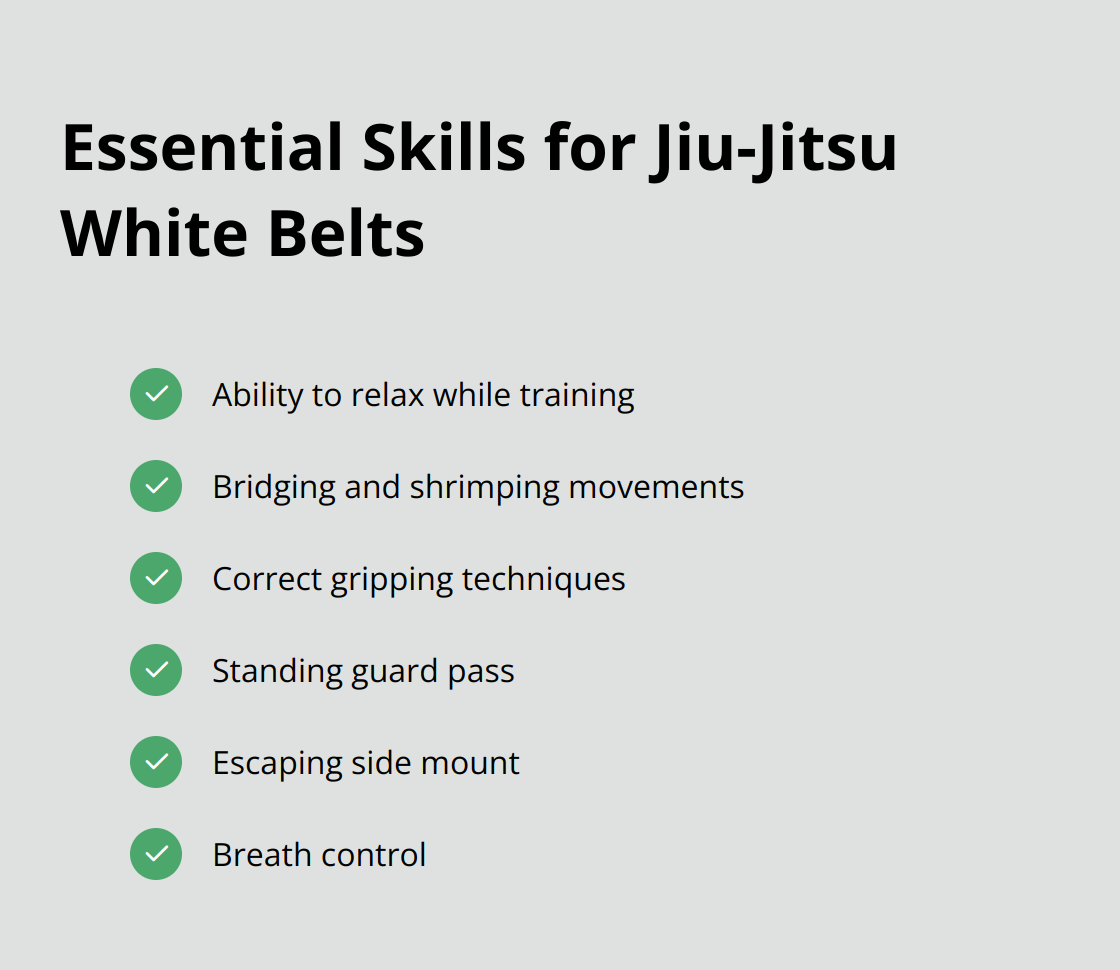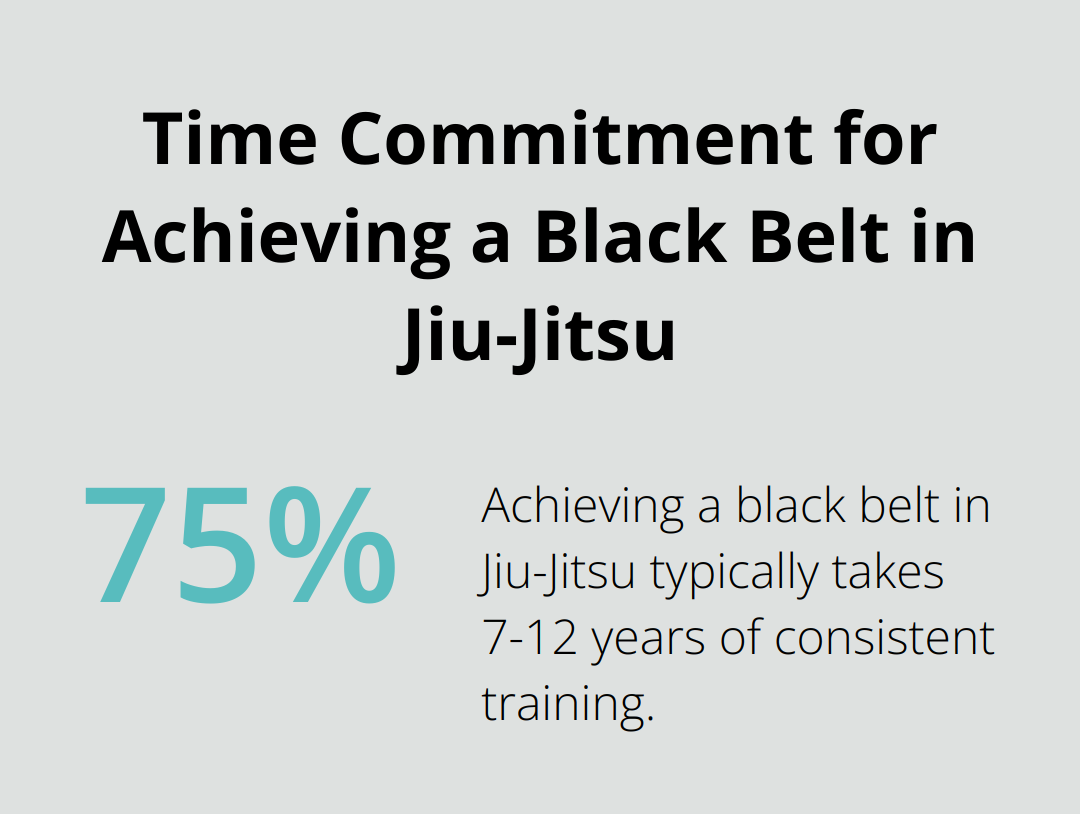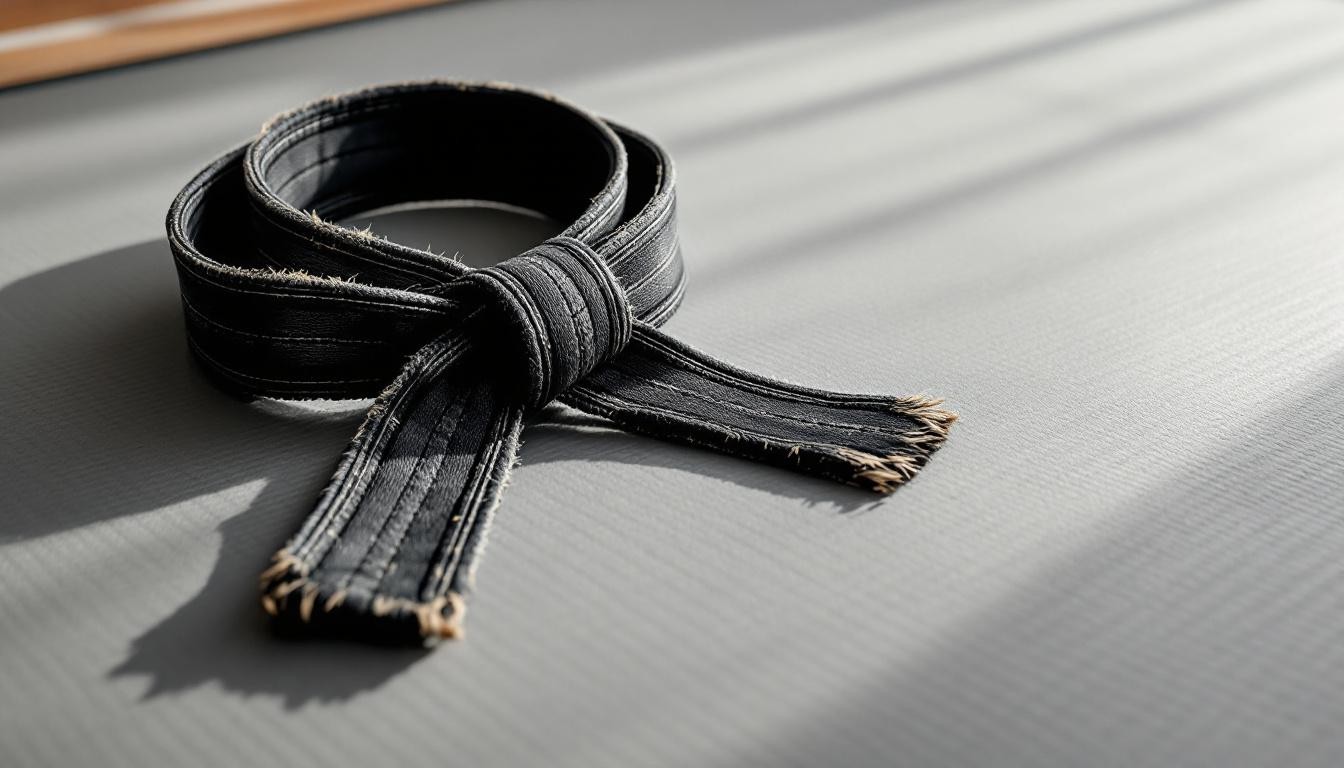At Jiu Jitsu, we know that the path to a black belt is a transformative journey. Many practitioners wonder, “How long does it take to get a black belt in Jiu Jitsu?” The answer varies, but it’s not just about time-it’s about dedication, perseverance, and continuous growth.
In this post, we’ll explore the stages of progression from white to black belt, highlighting the challenges and rewards along the way.
White Belt Foundations
Mastering the Basics
The Jiu-Jitsu journey begins with the white belt, where practitioners focus on building a solid foundation of basic techniques and positions. At this stage, you’ll learn basic skills such as the ability to relax while training, bridging and shrimping, gripping correctly, the standing guard pass, escaping side mount, and breath control. These skills form the backbone of Jiu-Jitsu and are essential for your development.

At Souza Grappling Co., our expert instructors emphasize proper technique from the start. They guide you through each movement, ensuring you understand not just how to perform a technique, but why it works. This approach helps you build a deep understanding of Jiu-Jitsu principles (which will serve you well throughout your journey).
Physical and Mental Challenges
The physical demands of Jiu-Jitsu can be intense for newcomers. You’ll likely experience muscle soreness and fatigue as your body adapts to the new movements. It’s important to listen to your body and rest when needed. Many white belts find that incorporating yoga or stretching into their routine helps with flexibility and recovery.
Mentally, you’ll face challenges too. It’s common to feel overwhelmed by the amount of information you absorb. Don’t get discouraged if techniques don’t click immediately. Jiu-Jitsu is a complex art, and progress takes time.
Developing the Jiu-Jitsu Mindset
The right mindset is key for long-term success in Jiu-Jitsu. Embrace the learning process and don’t focus solely on winning or losing during sparring sessions. Instead, view each roll as an opportunity to apply what you’ve learned and identify areas for improvement.
Souza Grappling Co. fosters a supportive community where white belts can learn and grow without fear of judgment. Our more experienced practitioners offer advice and encouragement to newcomers (creating a positive learning environment).
Tracking Your Progress
As you advance through the white belt ranks, you’ll notice improvements in your technique, physical conditioning, and mental resilience. These developments lay the groundwork for your journey to blue belt and beyond. Try to keep a training journal to track your progress and reflect on your learning experiences.
Preparing for Blue Belt
The transition from white to blue belt marks a significant milestone in your Jiu-Jitsu journey. As you approach this next stage, you’ll start to develop a deeper understanding of techniques and begin to form your own Jiu-Jitsu style. The skills and mindset you cultivate as a white belt will serve as a strong foundation for the challenges and growth that await you at the blue belt level.
Refining Your Game: Purple to Brown Belt
Crafting Your Signature Style
As you progress from purple to brown belt, your Jiu-Jitsu journey takes on new dimensions. This phase focuses on skill refinement, unique style development, and community contribution.
At the purple belt level, you master the fundamentals and prepare to develop your Jiu-Jitsu identity. This process involves identifying your strengths and preferred techniques, then building a game plan around them. For instance, if you excel at guard play, you might focus on perfecting your spider guard or developing a deadly De La Riva game.

Expanding Your Technical Arsenal
While specialization is key, it’s equally important to broaden your technical knowledge. This doesn’t mean becoming a jack-of-all-trades, but rather understanding a wide range of techniques to enhance your defense and counter-attacking abilities.
Many advanced students find success by incorporating elements from other grappling arts, such as wrestling or judo, into their Jiu-Jitsu game. This cross-training approach can add new dimensions to your skillset and make you a more well-rounded practitioner.
Embracing Competition and Teaching
Competition plays a vital role in your development at this stage. Competitions provide real-world testing grounds for your techniques and help identify areas for improvement.
Teaching is another important aspect of your growth. Many schools offer opportunities for advanced students to lead classes or assist with instruction. This not only deepens your understanding of techniques but also develops your ability to break down complex movements and explain them clearly – a skill that will serve you well as you approach black belt level.
Overcoming Plateaus and Setbacks
Progress isn’t always linear in Jiu-Jitsu. You will face plateaus and setbacks, but these challenges present opportunities for growth. Stay committed to your training, embrace the difficulties, and continue to push your limits.
As you navigate this crucial phase of your Jiu-Jitsu journey, you’ll find yourself on the cusp of achieving the coveted black belt. The next stage of your journey will test your dedication, refine your skills, and prepare you for the responsibilities that come with the highest rank in Jiu-Jitsu.
Mastering the Art: The Black Belt Journey
The Dedication Required for Black Belt
Achieving a black belt in Jiu-Jitsu demands unwavering commitment and perseverance. This milestone typically takes upwards of 7-12 years of consistent training. However, it’s important to note that the journey is completely subjective and can vary from person to person.

To reach this level, you must train at least 3-4 times a week (with many dedicated students opting for 5-6 sessions). This translates to approximately 2,000-3,000 hours of mat time before black belt consideration. However, the quality of your training matters as much as the quantity.
Continuous Learning and Skill Refinement
The learning process doesn’t end with a black belt; it marks the beginning of a deeper Jiu-Jitsu journey. At this stage, you must demonstrate a comprehensive understanding of techniques across all positions and execute them with precision.
One effective method for improvement is deliberate practice. This approach involves breaking down complex techniques into smaller components and perfecting each element. You might dedicate an entire training session to refining the details of your arm bar from guard (experimenting with different grips, angles, and setups).
The Responsibilities of a Black Belt
A black belt carries significant responsibilities. You transition from student to leader and ambassador for the art. Many black belts take on teaching roles, which requires not only technical proficiency but also effective communication and the ability to inspire others.
Black belts often contribute to the Jiu-Jitsu community beyond their local gym. This contribution might involve organizing seminars, competing at high levels, or developing innovative techniques. For example, the renowned black belt Marcelo Garcia revolutionized the art with his approach to the X-guard and butterfly guard (influencing countless practitioners worldwide).
Physical and Mental Challenges
The path to black belt tests both body and mind. Physical challenges include maintaining peak fitness, preventing injuries, and adapting to the evolving demands of high-level Jiu-Jitsu. Mental challenges encompass overcoming plateaus, dealing with competition pressure, and maintaining motivation through years of training.
Embracing the Lifelong Journey
A black belt signifies mastery, but it also represents the beginning of a new chapter. As a black belt, you commit to lifelong learning and improvement. You become a custodian of the art, responsible for preserving its traditions while contributing to its evolution.
Final Thoughts
The path to a black belt in Jiu-Jitsu transforms practitioners beyond the mat. It takes dedication, perseverance, and countless hours of practice to achieve this milestone. The journey spans a decade or more, with each belt representing technical proficiency and personal growth. Jiu-Jitsu cultivates discipline, problem-solving skills, and mental resilience that benefit all aspects of life.
We at Souza Grappling Co. encourage you to start your Jiu-Jitsu journey. Our facility offers a supportive environment where you can begin your path to mastery (guided by expert instructors). Whether your goal is fitness, self-defense, or personal growth, Jiu-Jitsu provides a rewarding path forward.
The question “How long does it take to get a black belt in Jiu-Jitsu?” has no simple answer. It’s a personal journey shaped by individual commitment and experiences. The black belt symbolizes achievement, but the true value lies in the growth and challenges overcome along the way. Step onto the mat and embrace your own Jiu-Jitsu journey today.




